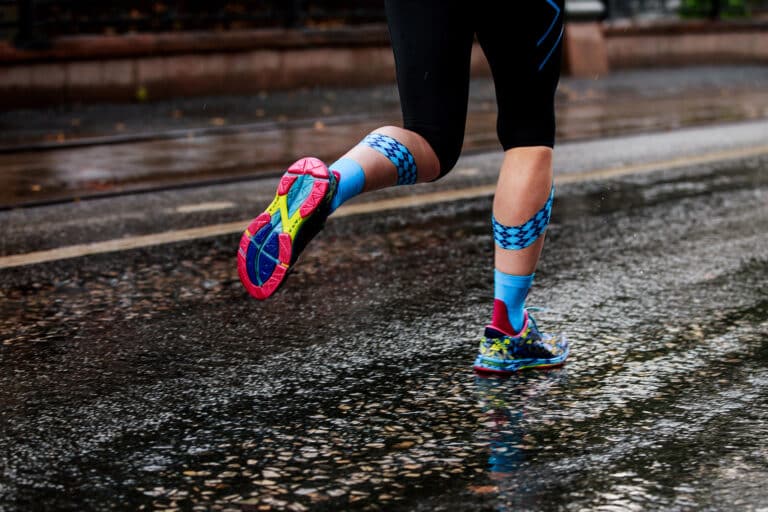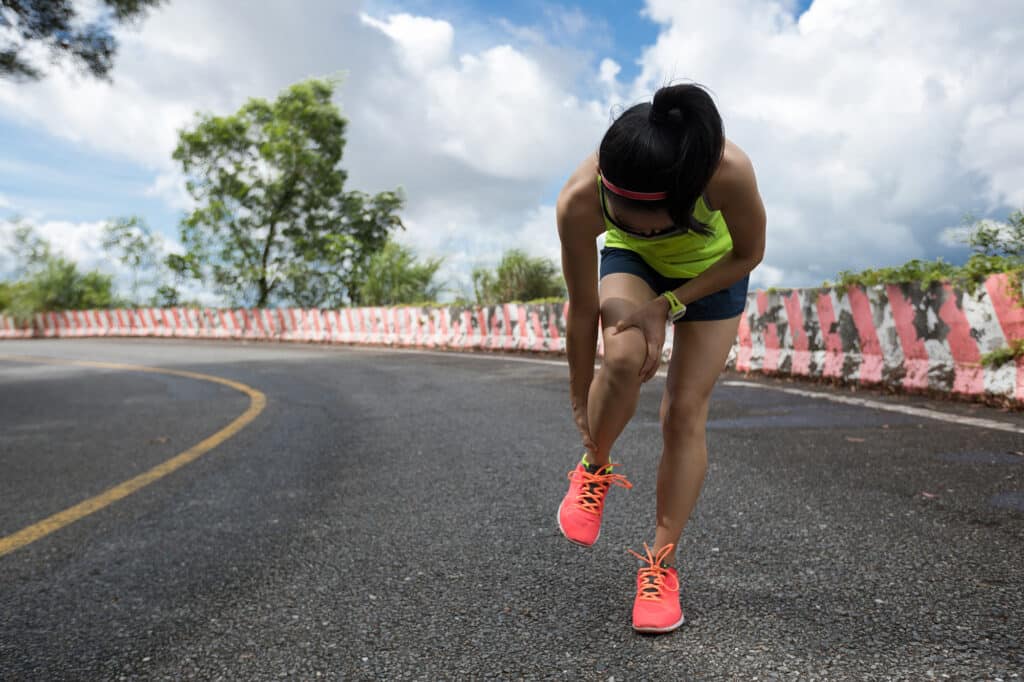


Falling while running can be an overwhelming and discouraging experience for any runner. Whether you’re a seasoned trail runner or just starting your journey, it’s essential to understand the reasons behind falling while running, tips to prevent tripping, and the benefits of a proper training plan.
In this blog post, we’ll discuss everything you need to know about falling and how to improve your running experience.

Unfortunately, falling while running is a common occurrence. It can result in bumps, bruises, scrapes, and even embarrassment. It’s not uncommon to trip occasionally on uneven terrain, but some runners seem to be more accident-prone than others. Regardless of your level of experience, falling can happen for various reasons. Here are some common factors that can cause runners to trip and fall:
Running on uneven terrain significantly increases the risk of tripping, especially if you fail to pay attention to your foot placement. Whether it’s uneven pavements, paths, or grass verges, the ground you run on may be riddled with cracks or obstructed by tree roots. This poses a constant threat of stumbling and falling. Even a small rock can become a potential hazard. Additionally, if the ground is slippery or loose, there’s a higher likelihood of landing awkwardly or with excessive impact on uneven surfaces.
Having an existing injury can significantly affect your stride and balance, resulting in a higher risk of falling. For example, if you’re dealing with a sprained ankle or tight hamstring muscles, your movements might be slightly compromised. Consequently, maintaining stability while running becomes more challenging, and the likelihood of tripping and falling increases. If you’re nursing an injury, it’s crucial to pay attention to your body’s signals and avoid pushing yourself too hard.
Improper landing of the foot can lead to loss of balance and potential falls. Some runners take long strides, distributing their weight over a larger surface area and compromising their overall balance. On the other hand, some runners fail to lift their feet high enough off the ground, causing them to stumble over even the smallest pebbles or sticks in their path. It is crucial to maintain proper foot placement to ensure stability and avoid unnecessary mishaps.
Insufficient rest and recovery can lead to muscle fatigue, increasing the risk of tripping and falling. When you’re tired, you may not pay enough attention to your surroundings or maintain proper form, making it easier to stumble over obstacles. Moreover, muscle fatigue can result in delayed reactions and slower response times when confronted with unexpected barriers. If you’re tired while running, your form may not be optimal, causing slouching or leaning forward, destabilising your core and affecting your centre of gravity and balance.
Wearing worn-out or ill-fitting running shoes can increase the risk of falls, as they may not provide the necessary support or traction for your specific running conditions. For example, running in old shoes can lead to reduced grip and stability on slippery or uneven surfaces. Similarly, wearing shoes that are too big or too small for your feet can affect your balance and raise the chances of tripping. Additionally, loosely tied running shoes can worsen these problems.
Preventing falls while running is simpler than you might imagine. While some falls are inevitable, many can be avoided by making a few adjustments to your running routine. To address these concerns and minimise the risk of falling, consider implementing these valuable tips:

To minimise the risk of slipping, losing grip, or sliding, it’s crucial to wear running shoes that provide the right fit, support, and traction for the terrain you’re running on. Investing in high-quality running shoes that suit your foot type and running conditions is essential. Remember to replace your shoes when they show signs of wear to maintain proper support and traction. Additionally, double knotting your shoelaces can be helpful.
Maintaining proper running form is crucial for preventing falls. To achieve this, keep your head up and look ahead, scanning the path in front of you to anticipate potential obstacles. Additionally, maintain a relaxed posture with your shoulders down and back, engaging your core muscles to ensure stability. Instead of taking longer strides, focus on increasing your cadence, taking shorter strides and lifting your feet off the ground to avoid stumbling. This will raise your centre of gravity and reduce the risk of slipping or tripping on uneven terrain. Strive for a steady and balanced stride, paying attention to your foot strike and overall stride to maintain better control and balance. If needed, consider consulting a running coach or joining a local running group for guidance and support.
Get used to different surfaces by running on various types of terrain, such as trails, pavements, and grass. This will help improve your balance and, strengthen your ankles and stabilising muscles. Don’t be afraid to occasionally challenge yourself with tougher terrain, but always start slow and gradually increase the intensity.
Running in the dark can be extremely hazardous without proper lighting. Even familiar routes can appear drastically different at night, with multiple bumps and cracks hidden from view. If you choose to run in low light or darkness, it’s crucial to wear reflective gear and utilise a headlamp or other light sources. This ensures you remain visible and also alert to potential obstacles, minimising the risk of tripping over unseen objects. Consider investing in a high-quality headlamp to effectively illuminate your path ahead and enhance your safety during nighttime runs.
Stay focused on your running path and avoid distractions like mobile phones or overly complicated music playlists that could take your attention away from your footing. If you need to make a call or send texts, stop running and step off the trail. Similarly, avoid wearing headphones that block out ambient noise entirely, as it can impair your ability to detect potential hazards. Remember, being aware of your surroundings is crucial for staying safe while running.
Never underestimate the power of rest and recovery. Adequate sleep and proper nutrition are vital for keeping your muscles and mind sharp. Always listen to your body’s signals for rest and avoid pushing yourself beyond your limits. Remember, recovery days are just as important as training days. They should be an integral part of your running routine to prevent physical fatigue and reduce the risk of falls due to delayed reactions or poor form. Running with tiredness can affect your form negatively, compromising your stride length, foot placement, and speed. Stay mentally and physically refreshed to make the best choices and maintain optimal performance.
In summary, falling while running can be due to various factors, but the proper precautions and adherence to a well-designed training plan can significantly reduce the risk of falling while running. The training plan should provide a balance between training and recovery, keeping you fresh and energised to maintain your balance and precision during your runs. Click here to check our recommended training plans that can help you avoid falling while running.
Ready for a speedy marathon challenge? Take a read of our 4 hour pace marathon blog.
By incorporating the tips we’ve mentioned, you can not only prevent falls but also improve your running experience and overall fitness. Stay safe and happy running!
Join our mailing list to stay up to date with the latest UK running events, training tips, and exclusive offers on running products. Rest assured, we value your privacy and would never dream of selling your address. Sign up now…
Share this article
During the summer months between marathon blocks, how should I tackle keeping sharp? I’ve seen...
On the 24-week marathon plan, the longest run is 18 miles. I’m wondering if 18...
Pronation refers to the way your foot rolls inward when you walk or run. Understanding...
Elevation gain refers to the total cumulative vertical distance ascended during a sport activity, such...
Aiming to complete a sub 3:30 marathon is no easy feat. It requires dedication, hard...
Hi Mike, I’m 43 and have run four marathons, with my most recent finish being...
We’re here to make sure you’re up-to-date with the latest running tips, events and product discounts – we’ve always got your back! Rest assured, we value your privacy and would never dream of selling your address.
BONUS: Sign up today and receive a FREE code for our Sub-4-Hour Marathon Plan